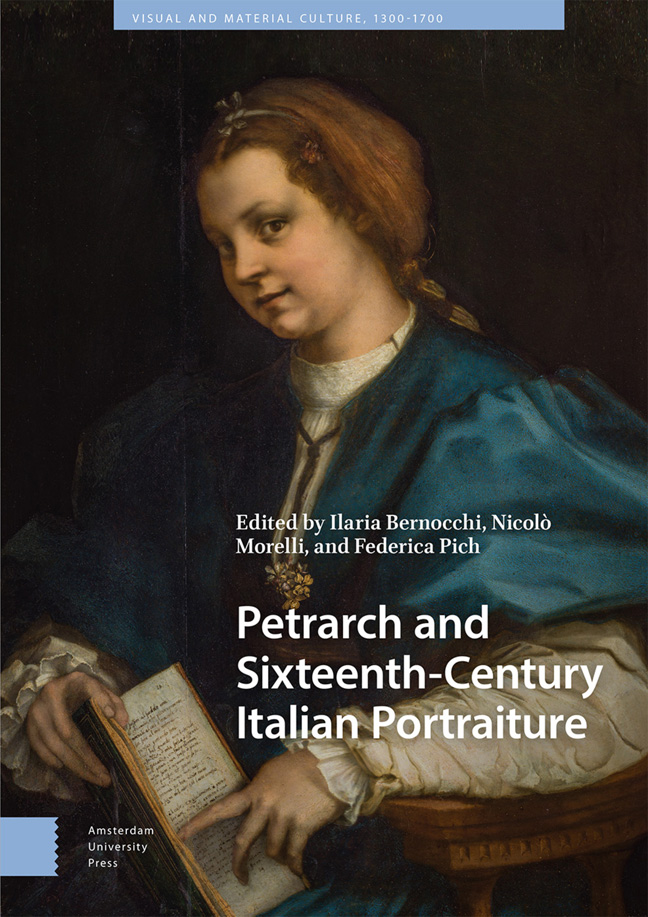Book contents
- Frontmatter
- Contents
- List of Illustrations
- Acknowledgements
- 1 Introduction
- 2 Widows, Poetry, and Portraits: Livia Spinola and Francesca Turina on the Portraits of their Dead Husbands
- 3 In Medusa's Eyes: Petrification and Marble Portraits in Late Sixteenth-Century Poetry
- 4 The Portrait of the Ideal Woman: Petrarch in Conduct Literature Texts for and about Women
- 5 Anti-Petrarchist Portraiture or a Different Petrarchist Portraiture?: A Literary Outlook on Some Non-Idealised Female Sitters in Renaissance Art
- 6 The Shadow of Petrarch: Benedetto Varchi and Agnolo Bronzino on Portraiture
- 7 Double Portraits of Petrarch and Laura in Print (c. 1544–1600)
- 8 Sonnet ‘Diptychs’ and Double Portraits: Figurative Allusions in Sixteenth-Century Encomiastic Poetry
- 9 Images of Women from Subject to Frame in Printed Portrait Books
- Bibliography
- Index
5 - Anti-Petrarchist Portraiture or a Different Petrarchist Portraiture?: A Literary Outlook on Some Non-Idealised Female Sitters in Renaissance Art
Published online by Cambridge University Press: 22 February 2024
- Frontmatter
- Contents
- List of Illustrations
- Acknowledgements
- 1 Introduction
- 2 Widows, Poetry, and Portraits: Livia Spinola and Francesca Turina on the Portraits of their Dead Husbands
- 3 In Medusa's Eyes: Petrification and Marble Portraits in Late Sixteenth-Century Poetry
- 4 The Portrait of the Ideal Woman: Petrarch in Conduct Literature Texts for and about Women
- 5 Anti-Petrarchist Portraiture or a Different Petrarchist Portraiture?: A Literary Outlook on Some Non-Idealised Female Sitters in Renaissance Art
- 6 The Shadow of Petrarch: Benedetto Varchi and Agnolo Bronzino on Portraiture
- 7 Double Portraits of Petrarch and Laura in Print (c. 1544–1600)
- 8 Sonnet ‘Diptychs’ and Double Portraits: Figurative Allusions in Sixteenth-Century Encomiastic Poetry
- 9 Images of Women from Subject to Frame in Printed Portrait Books
- Bibliography
- Index
Summary
Abstract
By focusing on two stylistically divergent treatments of the motif of the old female subject that were produced by major Italian artists between the 1490s and 1500s—specifically, one of Leonardo's ‘grotesque heads’ and Giorgione's La vecchia—the essay considers in what ways Renaissance depictions of aged women could engage with the literary authority of the Canzoniere. Thus, the enquiry will highlight how such an engagement with Petrarch's vernacular poetry, particularly with its recurrent meditation on the transience of the beloved's beauty, was sometimes inscribed not only in those artworks’ visual rhetoric, but also in their early reception.
Keywords: old woman; Petrarch; Leonardo; Giorgione; La vecchia; portraiture
A growing amount of research is casting light on the impact that Petrarchan ideals of beauty had on Italian Renaissance art. Following Elizabeth Cropper's seminal discussion of the physical features of some of Parmigianino's women as examples of visual Petrarchism, which centres on a limited set of features that distinguished Madonna Laura in the Canzoniere (e.g., the blonde hair, fair and fresh countenance, rosy lips with only a hint of a smile), scholars have come to understand how Petrarch's rarefied description of the female body shaped sixteenth-century depictions of belle donne. Comparatively little attention, however, has been given to the intermedial connection between the rhetoric of that poetry and that articulated in a number of non-idealised representations of old women produced by some Italian masters in the same period. What is more, in dealing with images of subjects who exhibit clear signs of ageing (grey hair, wrinkled and sagging skin), scholars have typically privileged a comparative focus with the portrayals of ugliness that were popular in Tuscan comic verse. This has lent some credence to the idea that such depictions were mostly conceived in antithesis to the sublimising conventions of the lyrical discourse on beauty, and that the relation they established with the Petrarchan model was one of parody or subversion.
While many sixteenth-century artists took a similarly debasing stance toward the authority of the Canzoniere, this essay contends that alternative modes of engagement with its model were also thought possible in portraiture of ageing women—ones that did not antagonise the lyrical code but were inscribed within it.
- Type
- Chapter
- Information
- Petrarch and Sixteenth-Century Italian Portraiture , pp. 105 - 128Publisher: Amsterdam University PressPrint publication year: 2023



